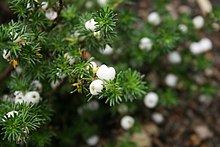Pearlberry
| Pearlberry | ||||||||||||
|---|---|---|---|---|---|---|---|---|---|---|---|---|

Pearlberry ( Margyricarpus pinnatus ) |
||||||||||||
| Systematics | ||||||||||||
|
||||||||||||
| Scientific name | ||||||||||||
| Margyricarpus pinnatus | ||||||||||||
| ( Lam. ) Kuntze |
The pearlberry ( Margyricarpus pinnatus ) is a species of the rose family (Rosaceae).
features
The pearlberry is a well-branched, evergreen dwarf shrub that reaches a height of up to 30 centimeters and a width of 1.5 meters. The branches are prostrate to ascending.
The alternate leaves are pinnate unpaired. The 7 to 15 seated, linear and pointed to spiky, entire-margined leaflets are 1.4-1.8 inches long and up to 1-1.2 millimeters wide, they are rolled over at the edge. The long shoot leaves have a weakly thorny central rib. The small, downy, hairy, ciliate stipules are fused with the base of the petiole.
The hermaphroditic, radial symmetry and sessile flowers usually appear individually in the leaf axils . The simple inflorescence is four or five-fold, the petals are missing. There are up to three short stamens with short stamens and large anthers. The individual, under constant carpel surmounted the flower cups not and contains only one ovule . The stylus is short, with a brush-shaped scar .
The 7–9 millimeter large, round and soft, single-seeded fruit ( false fruit ) is tinted white to pink, berry-like with a fleshy, inflated hypanthium and calyx remains at the tip. It often stays on the plant even longer. The seeds ( achenes ) are up to 4 millimeters in size.
The flowering period extends from April to June.
Occurrence
The pearlberry occurs in subtropical to temperate western South America on sand and rock corridors.
use
The mildly sour fruits are edible and are used raw and cooked. The pearlberry is rarely used as an ornamental plant for alpine houses and rock gardens. It is used in folk medicine.
Systematics
This species was in 1785 under the name Empetrum pinnatum by Jean-Baptiste Lamarck in Encyclopédie Méthodique, Botanique , 1, p 567 first published . It was placed in the genus Margyricarpus in 1898 by Carl Ernst Otto Kuntze in Revisio Generum Plantarum , 3 (3), p. 77 . Other synonyms for Margyricarpus pinnatus (Lam.) Kuntze are: Ancistrum barbatum Lam. , Margyricarpus imberbis C.Presl , Margyricarpus laevis Willd. , Margyricarpus setosus Ruiz & Pav.
The genus Margyricarpus belongs to the subtribe Sanguisorbinae from the tribe Sanguisorbeae in the subfamily Rosoideae within the family Rosaceae .
According to some authors, this genus contains a second species, Margyricarpus digynus (bitter) Skottsb. Some authors (for example Kalkman 2004) place the eight or so species of the genus Tetroglochin Poeppig in this genus. That would make a total of ten species instead of just one.
literature
- Eckehart J. Jäger, Friedrich Ebel, Peter Hanelt, Gerd K. Müller (eds.): Rothmaler excursion flora from Germany. Volume 5: Herbaceous ornamental and useful plants . Spectrum Academic Publishing House, Berlin / Heidelberg 2008, ISBN 978-3-8274-0918-8 .
- Margyricarpus Ruiz & Pavón. In: Carmen Ulloa Ulloa, Peter Møller Jørgensen: Trees and shrubs of the Andes of Ecuador. (Section Description and Use).
- James Cullen, Sabina G. Knees, H. Suzanne Cubey: The European Garden Flora. Second Edition, Vol. III, 2011, ISBN 978-0-521-76155-0 , p. 237.
- K. Kubitzki : The Families and Genera of Vascular Plants. Vol. VI: Flowering Plants Dicotyledons. Springer, 2004, ISBN 978-3-642-05714-4 , pp. 347, 364 f.
Web links
- Margyricarpus pinnatus at Useful Tropical Plants.
- Margyricarpus pinnatus on svenlandrein.com.
- Margyricarpus pinnatus on inaturalist.org (pictures).
Individual evidence
- ↑ Margyricarpus pinnatus at Tropicos.org. Missouri Botanical Garden, St. Louis.
- ^ Margyricarpus in the Germplasm Resources Information Network (GRIN), USDA , ARS , National Genetic Resources Program. National Germplasm Resources Laboratory, Beltsville, Maryland.
- ^ C. Kalkman: Rosaceae. In: K. Kubitzki: The Families and Genera of Vascular Plants. Vol. VI, 2004, p. 364.

